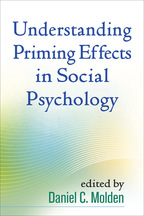Understanding Priming Effects in Social Psychology
Edited by Daniel C. Molden
1. Understanding priming effects in social psychology: What is “social priming” and how does it occur?, Daniel C. Molden
2. On the other side of the mirror: Priming in cognitive and social psychology, Stéphane Doyen, Oliver Klein, Daniel Simons, & Axel Cleeremans
3. Effects of evaluation: An example of robust "social" priming, Melissa J. Ferguson & Thomas C. Mann
4. Priming is not priming is not priming, Dirk Wentura & Klaus Rothermund
5. Structured vs. unstructured regulation: On procedural mindsets and the mechanisms of priming effects, Kentaro Fujita & Yaacov Trope
II. When and How Social Priming Occurs
6. Prime numbers: Anchoring and its implications for theories of behavior priming, Ben R. Newell & David R. Shanks
7. Understanding prime-to-behavior effects: Insights from the active-self account, S. Christian Wheeler, Kenneth G. DeMarree, & Richard E. Petty
8. Replicability and models of priming: What a resources computation framework can tell us about expectations of replicability, Joseph Cesario & Kai J. Jonas
9. Situated inference and the what, who, and where of priming, Chris Loersch & B. Keith Payne
10. Priming: Constraint satisfaction and interactive competition, Tobias Schröder & Paul Thagard
III. Considering New Sources of Social Primes
11. Grounding social embodiment, Daniël Lakens
12. Priming from others' observed or simulated responses, Eliot R. Smith & Diane M. Mackie
IV. From the Past of Social Priming to Its Future
13. Evaluating behavior priming research: Three observations and a recommendation, Ap Dijksterhuis, Ad van Knippeberg, & Rob W. Holland
14. The historical origins of priming as the preparation of behavioral responses: Unconscious carry-over and contextual influences of real-world importance, John A. Bargh
15. Priming . . . Shmiming: It's about knowing when and why stimulated memory representations become active, E. Tory Higgins & Baruch Eitam
16. Understanding priming effects in social psychology: An overview and integration, Daniel C. Molden



